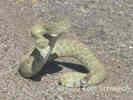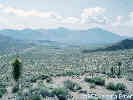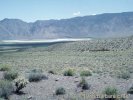 Carl Purpus, Plant Collector in
Western America
Carl Purpus, Plant Collector in
Western America Barbara Ertter
 Carl Purpus, Plant Collector in
Western America Carl Purpus, Plant Collector in
Western America | On the Trail, with Purpus, in California (Continued) |
| Barbara Ertter |
 




Topics in this Article: Literature Cited | |
|  Rattlesnake. Rattlesnake. Letters: 12/4/1896
Purpus could be very outspoken in his letters, and overgrazing by sheep
particularly aroused his ire:
| Yes, those sheepmen and their flocks ought to be exterminated unter all circumstances, they [sic] sooner, they better. It is not only a pity, no it is a shame and a sin to see those nasty sheep ruining that wonderful Mountain region and it's flora. It was more, than I could stand, and it made me so mad, that I more than a dozen times a day said to my guide "I could kill every one of those sheep", although I never kill animals except rattlesnakes! ..." [4 December 1895]
| Letters: 12/4/1896
The only group who received equal condemnation were "the woodchoppers"
in the Sequoia region: "... It is simply an outrage and I got so mad
about it that I felt as if I ought to pick up a club an[d] knocking
them down ..." [14 September 1895]
|
| When Purpus returned
from Sequoia Park in September of 1897, he found a
note from Katharine Brandegee inviting him to stay with the Brandegees
in San Diego. He accepted their invitation, leaving his field gear
in Springville. That winter he boarded a ship to the Galapagos Islands,
but instead got stranded near San Domingo in northern Baja California
after a ship-wreck. The letter describing the ship-wreck follows:
|
| San Domingo 19 Dec. 97
|
| Letters: 12/19/1897
Dear Mrs. Brandegee!
| I have to write You a very sad and bad news. We go shipwrecked near San Domingo at Lagoon head. How it happened I do not know, but we know that much, that the chain broke and we drifted a shore. The sea was very high but a dead calm. One of the man Mr. Drent a dutchman went on deck early in the morning about 5 o clock I guess and came back shouting "for gratious sake we are right in breakers!" Everybody ran on deck I jumped out of my bed, but the man told me to go back again to pack up my effects. The next thing was a hard shock after that one after an other one in quick succession. I packed up my sack and Mr. Brandegees pick and left my things in the bunk and ran on deck again, mean while one of the man went in to cabin and came back right away and told us the water was coming in and the cabin half full of water. After that the vessel turned to one side I was scared to dead, because I thought she would tip over, but she did not. the men told me afterwards it was imposible I did not know it. Not knowing what I was doing I left my satchel and everything in the cabin and if it was not for the men I had lost everything. Meanwhile the men got the boat ready, while we were hanging on the deck, our mexican officer sick with fright, but we got in to the boat after that. the men ran for our baggage packed it in to the boat and one of them took us a shore while they others packed the provisions on deck, what the could get and brought it a shore by and by. the vessel had settled and the very heavy breakers washed it on shore slowly. Yesterday the men went through the ship and got some more things out of the vessel and we packed it on shore. Today the vessel is so close on shore, that we can get in on dry ground, the heavy sea washed it in. I think the bottom of the shooner was no good, because the first shock made a hole and the water came in, but I may be mistaken--it was not on rocks, but on sand--. I lost my provisions, the baskets, Mr. Brandegees map and some other things. The men lost there clothing to safe ours. They all they could to bring us a shore in safety and I am under great obligation to them. The captain has let down and saw that nice little shooner helplesly washed on shore a play for the breakers, which swapped over the deck. We are going out collecting tomorrow, we had to much to do to safe the crop. The first night the men had to sleep on the beach to keep the coyotes away while I slept in the cabin. The coyotes are very numerous and it is a good thing, that we found the cabin to have the provisions on a safe place. They tried to get in the night before last, so I had to get up and fasten the door. I hope my letter will reach You after new year. I sent my best regards to Mr. Barrows, he will be surprised about that shipwreck. Very sincerely yours C. A. Purpus
| Letters: 1/3/1898 In a subsequent letter, the last
two lines are in Greek letters,
which spell out in English the statement "... Ant[hony] has made
a great mistake to give the vessel in charge of a half Lounatik ...";
very likely a reference to bearer of the letter!
Fortunately, the location yielded a marvelous diversity of cacti,
which pleased him enough to remain for over a month before
returning to San Diego.
|
| Other Articles: A Cactus Tour (1898): 0060 Locations: La Sal Mountains. Saint George.
In the middle of April of 1898, Purpus took the train back to
Springville to make preparations for his last expedition through
the southern Sierra Nevada and Owens Valley. His goal was to cross
southern Nevada and Utah to the La Sal Mountains, but because of
poor roads and drought conditions he turned around at
St. George, Utah. He and his companion, a man named Fred Noller,
left Springville with mules and a wagon at the end of April.
They followed their route of the previous year, crossing Greenhorn
and Walker passes to the Argus Range, where he stayed at the camp
of Georg Vornberg, "... a friend of mine from Baden [Germany]
who owns several gold mines in the area ...", at the foot of Argus
Peak.
|
| Locations: Salt Wells. Letters: 5/9/1898
A letter written from the Argus Range [9 May 1898] is one of Purpus's
more entertaining ones, including references to the difficulties in
pressing plants in the desert and his contacts:
|
I try the best to press the plants as nice as possible, although it is very hard sometimes on the road. Coming through the desert I had spread some plants out to dry near Salt Wells, covered with rocks. There came a whirlwind and away went one bundle sky high. I got the plants and paper again but not in good shape. I was raging made[sic] about it."
At Indian wells I made the acquaintance of Mr. Austin superintendent of the schools in Inyo Co. at Independence. He asked me to see him and his wife, who he says was a[n] enthusiastic botanist. He told me Mrs. Austin had received a beautiful Astragalus from a schoolboy with scarlet flowers he did not know the name. I told him it was very likely Astrag. coccin. Brandegee. Mr. and Mrs. Austin will be very valuable acquaintances. The Mrs. Austin of the letter is the same as writer Mary Austin.
|  Cow skeleton, Nevada.
Cow skeleton, Nevada. Letters: 5/9/1898
1898 was apparently a drought year, as evidenced by Purpus's letters.
A postscript to the same letter states, "It is a great pity to
see the cattle starve to dead on the desert, but it is a frolic for
me to see the sheep die."
|
|  Looking south to Darwin, California.
Looking south to Darwin, California.
Locations: Coso Mountains. Darwin. Keeler. Owens Lake.
| Purpus explored the eastern part of the Argus Range before crossing Junction Flat and skirting the northern portion, which Purpus called the Madurango Range. He then crossed the desert to Darwin, over the northern edge of the Coso Mountains, and along the edge of Owens Lake to Keeler.
| Other Articles: Nevada and Utah Desert (1898): 0040
| Our route traversed sparsely vegetated volcanic mountains, dark brown or burnt red, with a variety of extinct craters. We made camp facing broken volcanic rockpiles on top of the pass. The next morning we travelled through an exceptionally sandy region to Owens Lake, where we camped for a day next to a warm sulfur spring. The following day our journey continued to Keeler, situated in the center of a dry lake bed. To the east of Keller rose the deeply carved ridges and crater of the Inyo Mountains, with Pinus monophylla on its highest peaks. To the west, the snow-covered teeth of the Sierra Nevada ascended, blanketed in clouds.
| Other Articles: Nevada and Utah Desert (1898): 0050 Locations: Big Pine. Independence. Lone Pine.
Purpus and his companion arrived at Lone Pine, above which
Mount Whitney "... rose like a gigantic tooth amidst a row of lesser
peaks of similar shape, dropping vertically into a small valley ..."
From here they continued up Owens Valley to Independence
and on to Big Pine, where he noted an abundance of
Prunus andersonii, as well as Forestiera neomexicana.
They then turned east towards Westgard Pass, collecting for two days
at the "Tollhouse". "... We were presented with a magnificent
view of the freshly snow-covered high peaks of the Sierra
Nevada, shoved together like the side wings of a theater stage ..."
|
|
 Deep Springs from Westgard Pass, White Mountains, California.
Deep Springs from Westgard Pass, White Mountains, California.
Other Articles: Nevada and Utah Desert (1898): 0080 Locations: Deep Springs Valley.
They crossed the pass and descended into Deep Spring Valley,
arriving May 19, "a magnificent day". He describes his journey:
|
The route was at first rugged, then relatively flat through stands of Pinus monophylla, and then over a high plain beyond which we descended gradually into the valley. Deep Spring Valley is a meadow-filled valley enclosed by mountains, with a small lake located at its lower end. The lake is fed by strong springs on its southern banks. Here I rested a day and found at the lake's outlet the beautiful Philadelphus microphyllus, which until now had not been found in California.
| Other Articles: Nevada and Utah Desert (1898): 0090 Locations: Fish Lake Valley. Letters: 5/28/1898
Purpus also explored the mountains south of the valley before
crossing over to Fish Lake Valley: "... The southern end is for
the most part desert, but the northern is well watered and covered
with grassy flats. The Palmetto Range and Red Mountains are to
the east, and to the west are the White Mountains ..." That
night it rained in the valley and snowed in the mountains, giving
the landscape a wintery appearance. The next day they crossed the
border into Nevada. Here they spent over a week in the
Palmetto Range and Gold Mountain, waiting for the neck of one of
their mules to heal. Fortunately the collecting was good:
| I must say the whole mountain range is a perfect paradise for botanists at the right time and I guess I got here just in time, although for the high mountain flora it is much to early. [28 May 1898].In his next letter [2 June 1898] he describes some of the added features that made the area one of his more productive stops:
| Letters: 6/2/1898 | We camp at the Stateline mine, which is shut down for many years and I have rooms to dry my plants, to separate them etc as large, as Your herbarium and this is a very great accomodation because outside I could do nothing the wind is blowing sometimes so strong, that it takes our plates away. ... In the building where I dry my plants Ihave about 8 tables. I hardly think, that I will find an other place like this. Mr. Stewart who is watching the property of the Compagny[sic] is a very nice man and he takes a pleasure to help me in my work he is also a very valuable acquaintance for the future ... He also knows places where is thousands of Calochort[us] aureus or C. Kennedyi v[ar]. aur[eus]. On account of the very dry season it has not come up this year, so he will have them collect for us next year by squaws. He sent out a squaw after it but she could not find a single stem ... |
[Previous Page] [Next Page] | |
| [Published Biographies] [Travelogues and Articles] [Letters] [Plant Lists and Bibliography] [Site Administration] | | Date and time this article was prepared: 6/7/2002 7:32:40 PM |